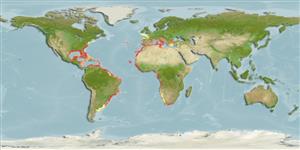Classification / Names
Common names from other countries
Main reference
Size / Weight / Age
Max length : 91.0 cm TL male/unsexed; (Ref. 9710); common length : 35.0 cm SL male/unsexed; (Ref. 4781); max. published weight: 7.7 kg (Ref. 40637)
Length at first maturity
Lm 26.6, range 19 - ? cm
Environment
Marine; benthopelagic; oceanodromous (Ref. 51243); depth range 0 - 250 m (Ref. 3688), usually 10 - 80 m (Ref. 9626)
Climate / Range
Subtropical, preferred 24°C (Ref. 107945); 55°N - 43°S, 98°W - 36°E
Distribution
Eastern Atlantic: Strait of Gibraltar to 15°N (rare southward 20°N), including Madeira and the Canary Islands; Mediterranean and northward to the British Isles. Western Atlantic: New York, USA and northern Gulf of Mexico to Argentina (Ref. 7251), including the continental coast of the Caribbean Sea (Ref. 9626).
Countries | FAO areas | Ecosystems | Occurrences | Introductions
Short description
Dorsal
spines
(total): 12;
Dorsal
soft rays
(total): 10;
Anal
spines: 3;
Anal
soft rays: 8. Pinkish silver with an indistinct yellow spot on each scale on about upper half of body, these spots giving a yellow-striped effect; a wedge of yellow across interorbital and some yellow on snout and upper lip; dorsal, caudal and pectoral fins pink (Ref. 13442)
IUCN Red List Status (Ref. 115185)
Threat to humans
Reports of ciguatera poisoning (Ref. 4690)
Human uses
Fisheries: commercial; aquaculture: commercial; gamefish: yes; aquarium: public aquariums
Tools
Special reports
Download XML
Internet sources
Estimates of some properties based on models
Phylogenetic diversity index
PD50 = 0.5156 many relatives (e.g. carps) 0.5 - 2.0 few relatives (e.g. lungfishes)
Trophic Level
3.9 ±0.2 se; Based on diet studies.
Resilience
Medium, minimum population doubling time 1.4 - 4.4 years (K=0.13-0.27; tmax=11; tm=0.9-3.0)
Vulnerability
High to very high vulnerability (66 of 100)
Price category
